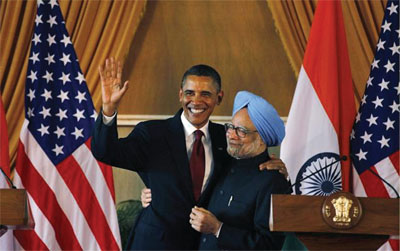
Guru Arjan Dev Ji installed Adi Granth at Harmandir Sahib Ji 1604. Baba Buddha Ji was the First Granthi and Bhai Gurdas Ji completed Adi Granth Sahib Ji as dictated by Shri Guru Arjan Dev Ji in 1604. Later Guru Gobind Singh Ji adds Shabads of Guru Teg Bahadur Sahib Ji and then in 1708, Adi Granth became Guru Granth Sahib Ji, the Eternal Guru of Sikhs as was declared by Guru Gobind Singh Ji.
The Guru Granth Sahib is indeed unique in its thought, literary expression and the message it continues to communicate centuries after it was written. Exalted thought needs to be transported on the vehicle of language to reach the masses. Poetic expression lifts prose to a higher plane.When verse and music meld, their beauty and sweetness makes mind transcend the humdrum of rational existence. This is divine love, passion pure expressed poetically; set to select 31 ragas…. The thought is egalitarian, expressed in a language that can be lucidly understood by the masses and the compositions are poetic, composed in the traditional Indian meters.
As Bhai Kahan Singh’s Mahankosh tells us, the Guru Granth Sahib contains the bani (sacred compositions, literally utterances) of six Gurus, 15-non Sikh bhagats (saints) whose bani was in consonance with the teachings of the Gurus, 17 bhattas (bards) and four others. Guru Arjan Dev, the fifth Guru of the Sikhs, had the bani of the first four Gurus compiled in a manuscript for which he asked Bhai Gurdas, a major Sikh theologian, to be the scribe. It was this manuscript, the Adi Granth, which was ceremoniously installed in the sanctum sanctorum of Harmandir Sahib at Amritsar in 1604 AD.
The manuscript also had Guru Arjan Dev’s compositons, the writings of bhagats and some others like Bhai Mardana and Sunder. The work of scribing the bani of the Guru started in the lifetime of the founder of Sikhism, Guru Nanak Dev. His compositions were carried in oral tradition as well as written down by his followers, even during his journeys.
There are references in Puratan Janamsakhi to Hassu Lohar, Shihan Chheemba, Saido Jat, and Tan Sukh Bania, who were also among those who accompanied Guru Nanak during his journeys or udasis and penned his bani. Guru Nanak had founded Kartarpur, at present called Kartarpur Ravi and Dera Baba Nanak. It is now in Pakistan, just across the Ravi and is visible from the Indian side. It was here that the Guru settled down with his family in the twilight of his life. He was then in his seventies. As Bhai Gurdas, who was later to scribe the Adi Granth (original manuscript), says: “The morning would begin with the recitation of Japji and Asa di Vaar, after which people would continue with their worldly duties. In the evening, Sodhar and Aarti were recited.” The Janamsakhis tell us that Guru Nanak compiled Japji and Asa di Va at Kartarpur.
He asked Bhai Lehna to assist him in editing these compositions. He was subsequently chosen, over his own sons, by Guru Nanak as his successor and named Angad, a part of oneself. As tradition puts it, Guru Nanak gave him the pothi (manuscript) that had 974 of his compositions (Pothi zuban Angad jog mili). Guru Angad added 63 of his compositions and gave the corpus to Amar Das, who was to be the next Guru. He was to add 907 compositions. Guru Amar Das made his grandson, Sahansar Ram, write the manuscript. It included the bani of Guru Nanak Dev, Guru Angad Dev and Guru Amar Das. The works of the bhagats were also included in it. A number of manuscripts were written, two of which are still available.
They are known as the Goindwal pothis. These pothis also have Guru Amar Das’s forceful message about bhagat bani’s inclusion and importance, and of how the bhagats were influenced by Guru Nanak (Nama chimba Kabir julaha pure Gur te gat pai). Guru Amar Das decided that the next Guru would be his son-in-law, Guru Ram Das. At this, his two sons were unhappy and they kept the manuscripts with them in order to project their own importance to the followers. The pothis were thus kept by Bhai Mohan, Guru Amar Das’ elder son.
The other major source of bani of Guru Nanak was the Harsahai pothi, which was with the family of the descendants of Prithi Chand, elder brother of Guru Arjan Dev. This manuscript was to remain with the family till it was stolen in 1970-71. When Guru Arjan Dev decided to compile the bani of his predecessors, there were thus a number of significant manuscripts that contained the Gurus’ compositions. Some had certain compositions that Guru Arjan Dev did not consider authentic. In order to consolidate the bani and prevent any spurious compositions from creeping into the original texts, he decided to have the Adi Granth compiled. The Tawarikh Guru Khalsa tells us that everyone who could contribute was asked to do so.
The Guru issued hukamnamas to all Sikhs, asking them to bring the bani of the Gurus to Amritsar, where the editing was to be done. He called the rababis (rebeck players) who had memorised the bani, as well as ordinary Sikhs, who had preserved the bani safely. It was with this corpus that the editing began. Every available source and content was carefully scrutinised and Guru Arjan Dev kept only what was considered absolutely authentic. The task of making the manuscript was entrusted to Bhai Gurdas. The compositions of the bhagats were also scrutinised. The bhagats whose works are contained in the Guru Granth Sahib came from different regions of India and wrote in regional languages.
The number of their compositions which were included is given along with their names: Kabir 541, Farid 116, Namdev 61, Ravidas 40, Trilochan 4, Beni 3, Dhanna 3, Bhikhan 2, Jaidev 2, Parmanand 1, Pipa 1, Ramanand 1, Sadhana 1, Sain 1, Surdas 1. The bhagats were from different religious denominations. They also belonged to different castes, including the so-called low castes, and came from different parts of the country like Uttar Pradesh, Bengal, Maharashtra, Mysore, Sindh, Rajasthan and Punjab. The bhagat bani gives a unique inter-religious, inter-regional flavour to the Adi Granth and the bhagat bani of the Guru Granth Sahib is a wonderfully catholic, cosmopolitan aspect of this scripture. While scribing the Adi Granth, Guru Arjan Dev ensured that the matter was arranged in a particular order and that everything was in proper context.
The author of each composition was identified; the context determined the placing of the bani; the appropriate ragas were determined; and the whole text numbered, so that nothing could be interpolated. Scholars contend that the earlier manuscripts were written without any break between words to prevent anyone from inserting anything between these, and this tradition continues. A raga is usually defined as a musical arrangement that brings forth love in one’s mind. The arrangement of ragas in the Guru Granth Sahib is, according to the Hanuwant system, without the raginis.
All the hymns are meant to be sung; and kirtan, the singing of the bani in an appropriate raga, is considered by Gurmat as an essential part of the religion and the sole form of worship among the Sikhs. Singing kirtan creates a shared community experience through repetition. After the Adi Granth was ready, the manuscript was taken in a ceremonial procession from Ramsar to Harmandir Sahib. Bhai Budha, who had come to Kartarpur and became Guru Nanak’s follower as a young lad, was now much revered. He now had a silver beard and he carried the Adi Granth on his head as a mark of respect. Guru Arjan Dev held a chowr (whisk), and the Sikhs, led by Bhai Gurdas, accompanied the solemn and grand procession to Harmandir Sahib, where the Adi Granth was installed. Guru Arjan Dev and other Sikhs sat at a lower level.
The bani of the Adi Granth held an exalted status. Baba Budha became the first Granthi. Soon more and more Sikhs concentrated on learning Gurmukhi, since the bani was written in this script. The Sikhs also started making copies of the manuscript of the Adi Granth, some of which can still be seen. While the installation of the Adi Granth at Harmandir Sahib was of great significance to the Sikhs, it also caused jealousy to some, especially the estranged relatives of the Gurus. This led to an interesting incident that finds mention in history. In 1605, when Emperor Akbar was visiting Batala in Punjab, he was told that the Sikhs had a holy book that contained passages that were blasphemous to Islam.
The Emperor called for the Adi Granth, which was sent by the Guru in the custody of Bhai Gurdas and Baba Budha. Bhai Gurdas, who had written every word of it, assured the Emperor that there was nothing against Islam, and that on the contrary, it contained hymns of Muslim saints. The Adi Granth was read at random in the presence of qazis and pandits. The first stanza said: “We are all children of our Father God.” When it was opened next, it said: “God pervades all His creation and the creation resides in Him. When there is nothing but God, whom should one blame.”
The Emperor realised that there was nothing blasphemous in the document and he made an offering of gold coins to the Adi Granth. Robes of honour were presented to both custodians of the Adi Granth. This became the first significant instance of someone recognising the intrinsic truth contained in the Adi Granth and thereafter making a symbolic offering to it, something millions do every day, the world over. Guru Gobind Singh, after adding 115 compositions of his father, Guru Teg Bahadur, and Jai Jai Vantee Raga to the extant 30 ragas in the Adi Granth, proclaimed near the end of his life that henceforth there would be no person who would be the Guru of the Sikhs.
The sole Guru would be the Word enshrined in the Guru Granth Sahib. The Word of faith, scribed for two centuries, was now complete and final.





Be the first to comment